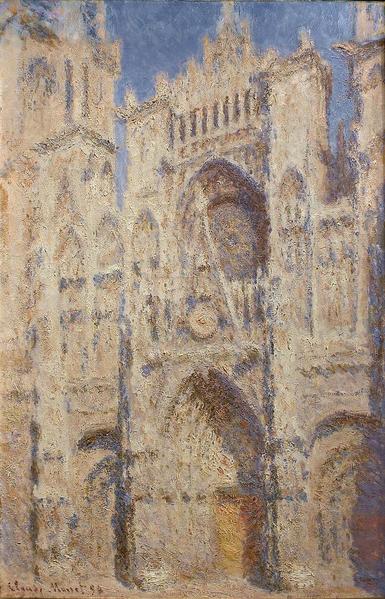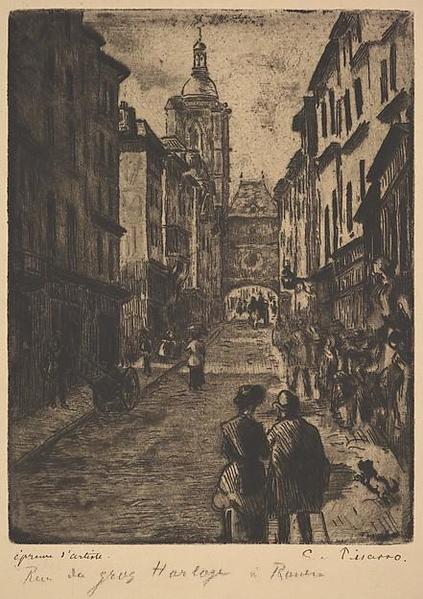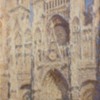 But Joan of Arc gives a clue. In the 15th century, control of Rouen, capital of Normandy, see-sawed back and forth between French and English rulers. In the 16th century, religious wars tore the city between Catholics and Protestants, which again brought war between English and French forces, and eventually a slaughter of Protestants.
But Joan of Arc gives a clue. In the 15th century, control of Rouen, capital of Normandy, see-sawed back and forth between French and English rulers. In the 16th century, religious wars tore the city between Catholics and Protestants, which again brought war between English and French forces, and eventually a slaughter of Protestants.
But even the 15th-century Hundred Years War came on top of frequent revolts of the poor, and passing of control between Norman rulers and the French monarchy. And even before that, Rouen was taken in the 9th century by Viking rulers, who gave their Norse name to the region and became French Dukes in 911. About 150 years later, one of them became king of England, as noted in a local street name:
Our visit, a day trip from Paris in late September, wasn't in search of history; I wanted to see more of Normandy than we had in the past, and to see the cathedral I'd seen so often in paintings and in art-history picture sets. It's a pleasant hour-and-a-quarter train ride from the Gare Saint-Lazare, ending up at Rouen's Art Nouveau main station, only a few blocks walk from the historic center.
Perhaps the best entry to the historic center is the one intended as such: one of the portals in the former town walls, adorned with a huge ornamental clock and an adjoining tower that contains its bells. It's the Gros Horloge, or Great Clock, and the Rue du Gros Horloge that passes under it was France's first officially pedestrianized street.
The title photo, at the top, shows the pointer of the clock's hand. Note hand: The clock's movement dates to the 14th century, although the faces, one on each side of the wall, are 16th century. The movement's maker had not yet mastered the technology needed to add a minute hand! The sheep at the tip tells you that wool trading was a major industry here through most of its history, along with trade along the river and to England.
At the end of the street, we found ourselves in the Place de la Cathedrale, with the famous facade, including the 'butter tower' at right, supposedly named because it was paid for with funds raised by selling indulgences allowing the eating of Normandy's famous butter during Lent. Its construction, by the way, created stress on the facade, and that had to be redone in the now-familiar Gothic flamboyant style. More on the Cathedral another day!
Across the square from the Cathedral are two more buildings of interest, and of quite contrasting styles. The Bureau des Finances, built around 1500, now houses the city tourism office and a tabac; in the late 1800s, the tabac was a lingerie store that rented a stockroom window on the second floor to Monet, who painted the Cathedral there. And next to it, the glorious Art Deco Grande Pharmacie du Centre, a classic in its own right, but controversial when it was built in the 1920s.
The building was not the only contrast we found; a block away we spotted a march, part of a national day of protest against Pres. Macron's new labor laws by France's unions. And on another corner, a bagpiper, playing for coins.
It's not only France and England and the Vikings in Rouen's history; it's the birthplace of Robert Cavelier de La Salle, who colonized what is now Quebec, and then went on to explore the Ohio and Mississippi rivers, eventually claiming a huge territory for France, and naming it Louisiana for Louis XIV. That's the land that eventually became the Louisiana Purchase by the U.S.
We interrupt Rouen for a brief muse about this train. We saw its mates in every place we went, just as 'trolley-themed buses' are a thing in every U.S. tourism destination. I still don't know why most of them in France say "Muson-River 1894" but I do know where they come from, and the manufacturer is happy to offer you one, custom-designed. They are Dotto trains, and they even have enthusiast groups!
At the Office du Tourisme, we got audioguides for a walking tour of the historic area, and started on our way, passing around behind the cathedral and its extensions, as well as some of the hundreds of timbered houses, centuries old. Worth noting that while in the U.S. we are used to buildings that are actually not timber-built looking that way, in Normandy the opposite can be true. The next picture shows a building that's been outfitted with a 19th-century facade, but with its timbered sidewall showing.
Our next major guidepoint after the cathedral was the Church of Saint-Maclou, actually dedicated to Saint Malo and built under English rule for Protestants. It's Catholic now, and quite spectacular. At its corner, samples of three different styles and colors.
Nearby, the audioguide took us into the Aître de Saint-Maclou. The center of this square became a cemetery during the Plague Year of 1348, when the nearby churchyard ran out of space. Nearly 200 years later, after another outbreak of plague, the buildings around the square were built to contain the bones of the dead, dug up to make room for more. Note the macabre motifs carved into the pillars.
Starting in the 1700s, the bones were removed and the buildings became a school; in the 20th century they became textile and craft workshops, and then up to 2014 studios for the Ecole des Beaux Arts. Now they are empty and waiting for their next use.
In addition to its amazingly-varied collection of half-timbered houses, there are more modern details to be spotted along the street, although they may often be on a remodeled but ancient building.
Clearly, not everything in Rouen is on the up-and-up, on the straight-and-narrow...
Our next big guidepoint was at the former Abbey Church of Saint-Ouen. The Abbatiale Saint-Ouen is as large as the cathedral, and was built between the 14th and 15th centuries; like the cathedral and Saint-Maclou, it's in the flamboyant stream of Gothic. It also has one of France's most important organs, built in 1890 and unaltered since.
Not too far away is Rouen's statue of Claude Monet "Homage of Rouen to the Painter of the Cathedral." Nice to know they focus on the local!
Not all of central Rouen is architecturally distinguished. During World War II, parts of the city, especially in the outer industrial areas, were bombed. In the center of the city, a post-bombing fire burned for two days in the area between the cathedral and the River Seine because German authorities barred firemen from entering. The depressing, if modern, shopping street above is in that area.
But practically around the corner from that is another Gothic treasure, unusual because it was built for civil rather than religious purposes. It was once the home of the Parliament of Normandy, and now serves as a courthouse.
A more pleasing mix of new and old, above, and the modern Halles de Rouen market, below.
Near the market, and reflecting its shapes, we came to the Church of Saint Joan of Arc, built in 1979 on the central market square at the same time as the new market. Its sweeping shapes were meant to suggest the flames that consumed her. The shape in general looks a bit like an overturned Viking longboat, a common shape for many early churches. In a later blog, we'll go inside. It's an amazing place. Just outside is a marker for the spot where she died.
And not very far from that, one of my favorite monuments all over France: a small carousel and children playing. And the end of a pleasant day in Rouen.
Rue du Gros Horloge, 1885, by Camille Pissarro




Comments (0)